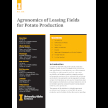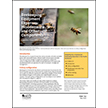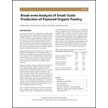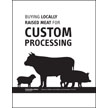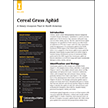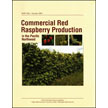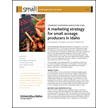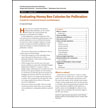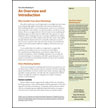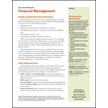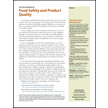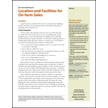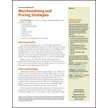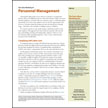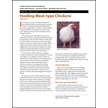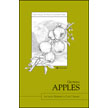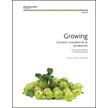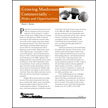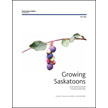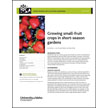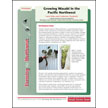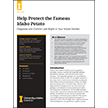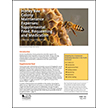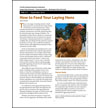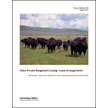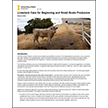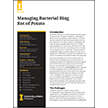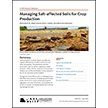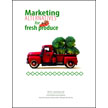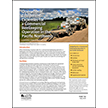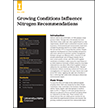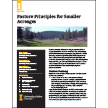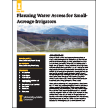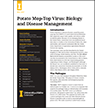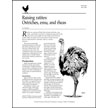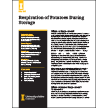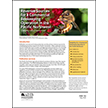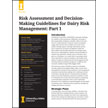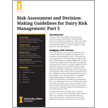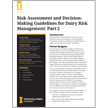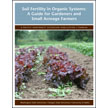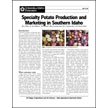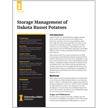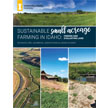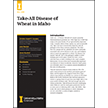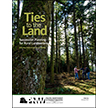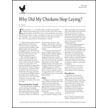Small-Acreage Farming
Agronomics of Leasing Fields for Potato Production
Leasing or renting fields for potato production may make it easier for growers to either start an agricultural career or expand one but be forewarned: gather as much background information as you...
Beekeeping Equipment Expenses: Woodenware and Other Components
Woodenware for a typical honey bee colony includes vertically stackable boxes with removable frames, a bottom board, lid and a queen excluder. The most common design is Langstroth equipment.
Break-even Analysis of Small-Scale Production of Pastured Organic Poultry
Data from five years of trials at Washington State University were used to compare costs and returns for pastured organic broilers using two strains of Cornish Cross meat birds, the industry...
Buying Locally Raised Meat for Custom Processing
Most people who buy meat from a local producer purchase a live animal (or a portion of one) and have it butchered by a "custom-exempt" processing plant. This publication explains how the process...
Cereal Grass Aphid: A Newly Invasive Pest in North America
Cereal grass aphid is a newly invasive aphid pest in North America. It colonizes cultivated crops like wheat, barley and oat, sucking their juices and using them as host sites for reproduction,...
Commercial Red Raspberry Production
$13.50 A comprehensive guide to commercial red raspberry production in the Pacific Northwest. Includes chapters on cultivar selection, plantation establishment, plantation maintenance, plant...
Community Supported Agriculture (CSA): A Marketing Strategy for Small Acreage Producers in Idaho
For some small-acreage producers, a CSA program is a valuable marketing strategy that contributes to whole farm sustainability. This seven-page publication helps growers think through whether CSA...
Creating Farmer Networks: A Toolkit for Promoting Vibrant Farm Communities
A toolkit for farmers, extension agents, community organizers, and other agricultural professionals interested in starting and maintaining a successful farmer network. The publication is divided...
Evaluating Honey Bee Colonies for Pollination
For commercial growers who rent honey bees for pollination and beekeepers who provide pollination services, here is information on honey bee colony strength evaluation, average number of colonies...
Farm-direct Marketing: An Overview and Introduction
This revision summarizes benefits, drawbacks and requirements of several direct marketing options, including farmers markets, farm or roadside stands, Community Supported Agriculture (CSA), U-pick,...
Farm-direct Marketing: Costs and Enterprise Selection
This revision covers how to do a general budget analysis for your farm-direct enterprise. Includes how to identify fixed and variable costs and do a breakeven analysis. Author: Larry Lev 6 pages
Farm-direct Marketing: Financial Management
This revision looks at several aspects of a successful farm-direct enterprise, including benefits of good farm financial planning, explanation of important terms used in financial planning, keys to...
Farm-direct Marketing: Food Safety and Product Quality
This is the new, eighth publication in the Farm-direct Marketing set. Includes information on aspects of keeping your products fresh and safe, such as proper cooling, handling, storage, chilling...
Farm-direct Marketing: Legal Guide to Farm-direct Marketing
This is the new, seventh publication in the "Farm-direct Marketing" series. Covers the risks and regulations associated with a farm-direct small business, including choosing and registering a...
Farm-direct Marketing: Location and Facilities for On-farm Sales
This revision discusses aspects of good location and facilities for a farm-direct marketing business, including location, site selection, parking and types of facilities (such as a roadside stand...
Farm-direct Marketing: Merchandising and Pricing Strategies
This revision discusses the strategies direct marketers use to make sales. It includes making a merchandising plan, display and packaging, customer service, pricing strategies and techniques, and...
Farm-direct Marketing: Personnel Management
This revision includes information on complying with labor laws, ways to find good employees, employee orientation and training, employee policies and employee management. Author: Christy Anderson...
Guidelines for feeding small flocks of meat-type chickens. Including a discussion of standard versus organic feeds, mixing feeds at home and alternatives to traditional ingredients. This...
Growing Apples for Local Markets in Cold Climates
Offers the basics for getting started in a small scale commercial apple orchard, including sections on rootstocks, apple varieties, training and pruning, winter protection, fertility and...
Growing Blueberries in the Inland Northwest & Intermountain West
Highbush and lowbush blueberries are native to North America and can be harvested two to three years after planting. This publication covers selecting a growing site, recommended cultivars,...
Growing Currants, Gooseberries and Jostaberries in the Inland Northwest and Intermountain West
This 21-page publication provides basic information on growing these fruits, which are common in Europe. Includes detailed lists of recommended cultivars, as well as information on fertilization,...
Growing Mushrooms Commercially-Risks and Opportunities
Learn the basics of what you need to do to grow and sell mushrooms (especially specialty varieties, which are any mushroom species that doesn't belong to the genus Agaricus). You'll need to...
Growing Raspberries and Blackberries in the Inland Northwest & Intermountain West
Raspberries and blackberries have similar growing requirements and offer a market advantage to commercial growers, providing local customers with high-quality fruit. This publication covers,...
Growing Saskatoons in the Inland Northwest and Intermountain West
Saskatoons are shrubs that bear blueberry-like edible fruit. Popular in Canada, this superfood, a powerful antioxidant, is gaining the interest of U.S. growers, who know it by other names like...
Growing Small-Fruit Crops in Short-Season Gardens
Choosing hardy and early maturing small-fruit varieties is critical to gardening success as is using proper maintenance techniques. Part of the Short-Season, High-Altitude Gardening series, this...
Growing Strawberries in the Inland Northwest & Intermountain West
This publication covers selecting a growing site, recommended cultivars, preparing the site, planting, training, irrigation, fertilization, weed control, winter protection, pest and disease...
Growing Wasabi in the Pacific Northwest
Describes wasabi cultivar selection, propagation methods, growing environments, irrigation and fertilizer needs, planting requirements, weed control, harvest considerations, storage, insect and...
$3 From a leading huckleberry expert comes the information you need to start your own attempts at growing huckleberries at home or for market. This publication covers plant and growing site...
Help Protect the Famous Idaho Potato: Diagnose and Control Late Blight in Your Home Garden
Potato and tomato plants are susceptible to late blight, a disease caused by a fungal-like pathogen that caused the Irish Potato Famine of 1845–52. The disease is still with us today and continues...
Honey Bee Colony Maintenance Expenses: Supplemental Feed, Requeening and Medication
Success in pollination, honey production and other aspects of a beekeeping business depends on honey bee health. Strong, thriving colonies require many inputs from the beekeeper, including feed...
This publication helps small-flock chicken producers select the correct feeds and manage watering to meet the nutritional needs of their laying hens at specific stages of the birds' development.
Idaho Private Rangeland Grazing — Lease Arrangements
Although the USDA publishes lease rates for grazing on private rangelands in Idaho, little it known about the leasing details, services provided by landowners or other critical factors that...
Livestock Care for Beginning and Small-Scale Producers
Owning and caring for livestock involves a lot of responsibility and exposes producers to a steep (and fast) learning curve, especially for those just starting out and/or who run small-scale...
Managing Bacterial Ring Rot of Potato
Bacterial ring rot, caused by the bacterium Clavibacter sepedonicus, is one of the most destructive potato diseases in the world. Because losses due to stored, decaying potatoes can be substantial,...
Managing Salt-affected Soils for Crop Production
Salt accumulation in soil can reduce crop yields and destroy a soil’s structure if not managed effectively. In this 21-page publication, learn how to test for and evaluate the salts present in...
Marketing Alternatives for Specialty Produce
Describes marketing and farm business management for Pacific Northwest vegetable and fruit growers as well as a snapshot of practices used in specialty agriculture. Authors: Larry Burt, Curt...
Operational Equipment Expenses for a Commercial Beekeeping Operation in the Pacific Northwest
When developing a business plan for a commercial beekeeping operation, a beekeeper must plan for honey production. Even if other income sources, such as pollination or nucleus/package/queen sales,...
Optimum Nitrogen Rates for Wheat Depend on the Environment and Field-Specific Conditions
Nitrogen is vital for crops — it is an essential nutrient whose efficient absorption makes high crop yields possible. Despite significant developments in wheat breeding and nutrient management,...
Pasture Principles for Smaller Acreages
Ranchettes and small farms are cropping up in rural landscapes across Idaho, spurring demand for information on pasture management. This updated publication addresses the most common concerns...
Planning Water Access for Small-Acreage Irrigators
Small acreage landscapes pose unique water-access problems, particularly when they are subdivisions of a larger-acreage property. Improve your navigation of these challenges by learning the basics...
Potato Mop-Top Virus: Biology and Disease Management
Potato mop-top causes dark, internal blemishes in potatoes. Because it is an emerging disease in the United States and no control measures yet exist, growers need to know the basic facts to...
Raising Ratites: Ostriches, Emu, and Rheas
Ratites are mostly large, flightless birds that exist in the wild in Australia, Africa or South America. But U.S. growers have been raising them as alternative and likely healthier meat sources for...
Respiration of Potatoes During Storage
During potato harvest, respiration becomes a crucial metabolic process. Its effectiveness determines how well a potato survives storage. Learn more about the aerobic respiration process, its...
Revenue Sources for a Commercial Beekeeping Operation in the Pacific Northwest
Pollination services and honey production are the primary revenue sources for a beekeeping business based in the Pacific Northwest. Those starting a beekeeping operation should focus on two to...
Risk Assessment and Decision-Making Guidelines for Dairy Risk Management: Part 1
Dairy farmers, particularly those who run small- and middle-sized enterprises, face significant economic challenges. Financial guidance is more critical than ever. This three-part series addresses...
Risk Assessment and Decision-Making Guidelines for Dairy Risk Management: Part 3
Dairy farmers, particularly those who run small- and middle-sized enterprises, face significant economic challenges. Financial guidance is more critical than ever. This three-part series offers...
Risk Assessment and Decision-Making Guidelines for Dairy Risk Management: Part 2
Dairy farmers, particularly those who run small- and middle-sized enterprises, face significant economic challenges. Financial guidance is more critical than ever. This three-part series offers...
Soil Fertility in Organic Systems: A Guide for Gardeners and Small Acreage Farmers
Managing soil fertility is challenging because it requires considerable focus — you must consistently pay attention to the source, timing, rate and placement of nutrient applications. This...
Specialty Potato Production and Marketing in Southern Idaho
U.S. customers are increasingly willing to pay higher prices for gourmet or specialty potatoes that come in a variety of colors and sizes. According to marketing surveys, eight specialty cultivars...
Storage Management of Dakota Russet Potatoes
Dakota Russet is a multipurpose and popular potato cultivar whose Pacific Northwest acreage has expanded in recent years. With increased yields comes larger storage volumes. Based on the results of...
Sustainable Small Acreage Farming in Idaho: Finding and Evaluating Land
Small acreage farming allows people to produce their own food and to develop various farm-based business enterprises. Establishing a small farm requires time and attention to many details.
Take-All Disease of Wheat in Idaho
Take-all is a highly destructive fungal disease of cereals whose ability to infect multiple plant parts often results in a crop’s complete destruction. Mainly found in wheat, barley, rye and...
Ties to the Land: Succession Planning for Property Owners
Whether you own a farm, forest or rangeland, you care about your property and what happens to it. That's why you need a succession plan to help guide its transition to future owners. Ties to the...
Understanding Budgets and the Budgeting Process
Budgeting is crucial to a business' success. This publication helps you navigate this often intimidating task by discussing the four budget types most commonly used by agricultural producers (whole...
Why Did My Chickens Stop Laying?
Hens stop laying eggs for a variety of reasons but hormonal fluctuation is the main one. This publication briefly discusses what triggers that effect, including decreasing day length, molting,...







